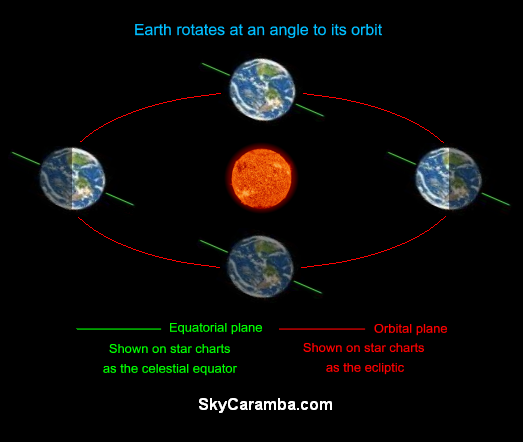¡SkyCaramba! Weekly astronomy blog for the week ending February 8, 2014
 If you look at the pages of an almanac, you’ll occasionally see that the moon is at ascending node or descending node. Julie Threadgill, who saw such a message following SkyCaramba via Facebook, asks what that means. It means the moon is crossing a line in the sky that the sun travels on over the course of a year.
If you look at the pages of an almanac, you’ll occasionally see that the moon is at ascending node or descending node. Julie Threadgill, who saw such a message following SkyCaramba via Facebook, asks what that means. It means the moon is crossing a line in the sky that the sun travels on over the course of a year.
You can probably make a good guess where the celestial equator is. During the day, the sun crosses the sky somewhat close to it. But actually only twice per year, at the equinoxes, is the sun exactly on it. For six months after the March equinox, the sun is north of the celestial equator. Then for six months after the September equinox, the sun is south of it. The line the sun actually rides throughout the year is called the ecliptic.
As the sun slowly moves north or south of the equator during the year, it’s also moving slowly eastward against a background of stars we don’t see during the daytime, except during a total solar eclipse. The sun moves along the ecliptic, because the ecliptic is the plane of the earth’s orbit. That makes the ecliptic as important a reference in astronomy as the equator.
The other planets from Mercury to Neptune orbit at angles compared to Earth. But not at big angles. They always appear to be near the ecliptic. Many astronomers describe their positions in terms of how far north or south they are from the ecliptic.
When the moon crosses the ecliptic going northward, it’s said to be at ascending node. Likewise, going south across the ecliptic is descending node. Most months, the moon doesn’t look any different just because it’s at either node. However, sometimes the moon lines up neatly with the earth and sun for an eclipse. That can only happen when the moon is at or very close to ascending or descending node.
A solar eclipse happens when the moon is new and a lunar eclipse happens when the moon is full. If a new moon happens more than about a day before or after a node, there won’t be a solar eclipse. Just the same, unless a full moon happens within a day of a node, there won’t be a lunar eclipse.
The ecliptic and the equator are often shown on star maps. They’re also displayed in planetarium software. The ecliptic is usually marked by degrees east of the March equinox position, while the ecliptic is usually marked in hours, minutes, and seconds. One full rotation is 360° and 24 hours.
As you trace the ecliptic’s route across the sky, you may notice it goes through all of the same constellations we call the zodiac. Thousands of years ago, the sun’s apparent route through the sky became the basis for many astrological systems.
In case you find it hard to visualize the differences between the ecliptic and equatorial planes, there are some graphics with this article. You’ve certainly seen a diagram of the earth’s axis being tilted and that having everything to do with why Earth has seasons. Now you know this is also why there are two lines that go all the way around celestial dome charts.
¡SkyCaramba!
